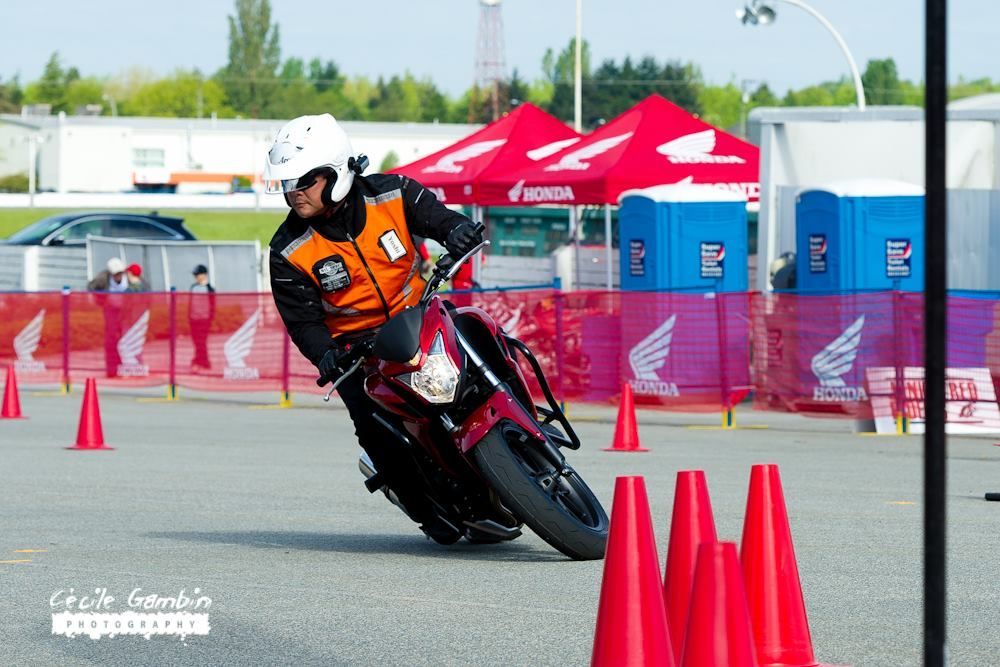Advanced motorcycle braking techniques for the best cornering
Toronto, Ontario, Canada
Before I use this account, I used different one on ESR and posted this article. Some of you might have not read, so I just brought it here for you.

Demo-Riding at Honda Rock the Red Moto-Gymkhana Event
'How can I improve cornering?'
If you want to improve cornering on your motorcycle, you never focus on speed but rather accuracy and smoothness. Many riders ask me “How can I improve cornering?” but really 90% of riders have a problem when “approaching”.
Approaching consists of three things:
1: Choosing Line
2: Slowing down
3: Turning-in (leaning) THEN, it continues to...
4: Cornering
5: Exiting with Acceleration
You can also analyze yourself which part you are not good at…if you are not sure, ask someone who is properly trained (like an instructor) to follow you.
Again...the most important part is...."Never focus on speed but accuracy and smoothness".
Braking is most important skill in good cornering
Usually, I barely go riding on winding roads on my motorcycle because many of those roads are really far from Toronto, but today, I thought I'd write some tips about cornering.
As you know, before you make a turn, you've got to adjust speed and posture. I will not talk about the line of riding today but rather the technique for braking.
You will never ride like a race-bike rider on the street. Our (Street Riders) focus is different, however, there are some similarities in techniques we use.
I don't know if you agree, but since I work as an instructor, I often analyze & break-down the procedure step-by-step and this is what I do when I ride sport-style.
Steps to braking when cornering
1, See the corner ahead (either right or left corner).
2, Slightly offset my body (not like race-style but only an inch or so) if needed.
3, Start applying REAR BRAKE first.
4, Start applying FRONT BRAKE slightly after the REAR.
5, Bring my body upright a little bit, even at slower speed-range, using wind-resistance.
Momentum moves the body forward as you apply braking, so adjust the weight balance of front & back. You must brace your body with your abs, thigh and feet (around ankle)...NEVER brace with your arms.
6, Gear down one gear at a time with applying both front and back brakes. I would use BRIPPING technique WHILE braking if needed.
The most difficult part of bripping while braking is that you MUST move the throttle only. Not with brake lever, otherwise the bike will not be stable.
7, Finish adjusting speed before getting to the "turn-in" (start leaning) zone.
8, Just before entering the "turn-in" zone, I will turn my HEAD & CHEST towards the exit of corner....prepare for leaning.
Time to corner
Maybe the time of executing steps 1~8 will take only 2~3 seconds. Let's make it 3 seconds, for example, here are some math calculations.
If you're riding on the highway at 100 km/ph (60 mi/ph) your speed will give you approximately 30 m/sec to do all the steps. So, start preparing the above 1~8 skills, 90 meters (300 feet) before the corner.
If riding at 80 km/ph (50 mi/ph), your speed will give you about 24 m/sec, so start preparing the above 1~8 skills 72 meters (240 feet) before the corner.
If riding at 60 km/ph (40 mi/hr) you have 18m/sec so start preparing at 54m (175 feet) before the corner.
AGAIN, checking your own riding skill is really important. Especially when BRAKING. I can say, braking is the most difficult one in all motor sport no matter what category is.
Why apply rear brake before the front?
Good question. I'll answer very easily to everyone. Consider the reactions of the bike, broken down here step-by-step.
1: Apply rear brake slightly, rear-suspension sinks (compresses)
2: Counter reaction, the front suspension stretches a little
3: Then apply front brake, remove the "play" first
4: Slightly apply front brake, get the front suspension to start compressing (getting traction)
5: Then apply front stronger like squeezing an orange (to get friction & resistance)
If you want to come to a stop, just keep applying the brake till the bike stops. This is the threshold stop technique with full-braking.
If you want to use just full-braking without a stop such as riding on the race-track etc., you will need to add "Down-Shifting procedure" in between steps 4 & 5.
Without applying the brake, the front suspension sinks slightly with its weight. Using the rear brake can stretch the front out slightly, and that makes it increase the travel distance of compression, meaning you can maximize the ability of front brake and front suspensions.
How strong do you need to apply both the front and rear brakes? Well that is the difficult part, it depends on your bike and HOW you are riding.
I broke down these steps, HOWEVER, the important key is that you must operate these steps "CONTINUOUS FLOW....SMOOOOOOOTHLY".
Safe ride everyone !